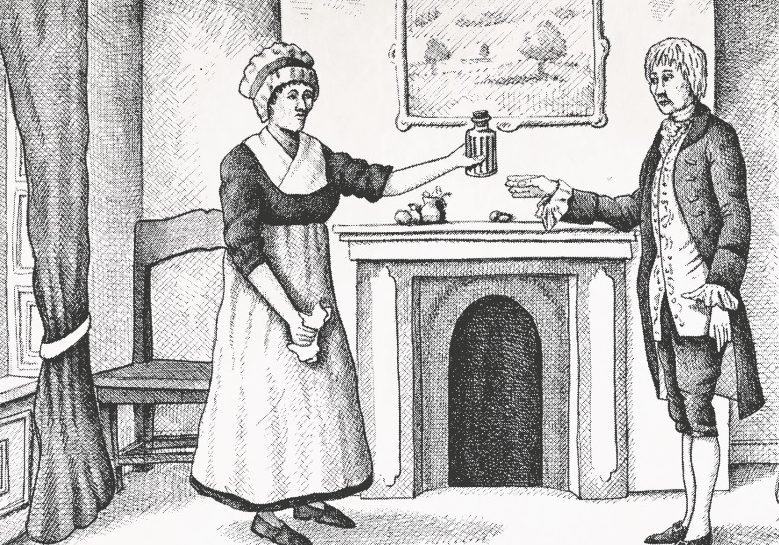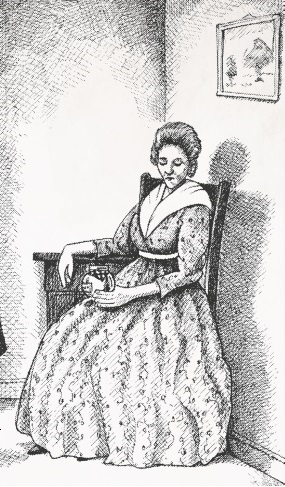
Mary Bateman – ‘The Yorkshire Witch’
by Josh Swarbrick
Almost every aspect of Mary Bateman’s extraordinary life is coloured by her long (and almost unbelievable) list of crimes – from your typical robberies and frauds, right down to the forging of prophetic eggs foretelling the coming of Christ.
The turn of the 19th Century marks the beginning of a time notoriously rife with criminal activity – with theft, fraud, and murder (sometimes even all three at once) frighteningly commonplace. Yorkshire was no exception, largely thanks to the work of a single crime-loving lass. Almost every aspect of Mary Bateman’s extraordinary life is coloured by her long (and almost unbelievable) list of crimes – from your typical robberies and frauds to the forging of prophetic eggs foretelling the coming of Christ…
Born in 1768 in the quiet little town of Asenby, about 26 miles north of Leeds, Mary’s early life was rather ordinary, to say the least – she learnt to read and write at a young age, was raised by her farming family for a life of domestic work, and eventually began work as a servant girl, age 13, in the neighbouring town of Thirsk. She would later move to York to pursue work as a dressmaker. This perfectly normal upbringing, however, began to be muddied by flashes of Mary’s tendency for criminal activity.

Mary and the Perigos – 1960s book illustration
A couple of minor thefts in her late teen years sparked an apparent passion for crime that showed no signs of stopping. In 1789, mere months after first arriving in York, Mary fled to Leeds after being involved in a burglary. Whilst she put her dressmaking skills swiftly to work – taking on a job making mantuas (a jacket-like bodice made of elaborately patterned fabric) – the pay was poor, and Mary turned to the highly profitable trade of fortune telling to make ends meet. Mary became what locals referred to as a ‘wise woman’ – a woman well versed in charms and fortune telling and who was available for consultation to remove spells or bad omens from an inquirer. Yet in spite of the newfound local fame this trade brought, Mary’s secretive life of crime only continued to grow. Perhaps most worryingly, many of these crimes started to actively target members of the public, from stealing the possessions of lodging house residents to committing acts of fraud by making purchases in the name of established customers.

An illustration of Mary at work inscribing eggs
A particularly well-documented incident followed a devastating fire in Leeds, with Mary roaming the streets begging for money and goods to support the victims, only for her to pawn off the items she received for her own profits. Mary left Leeds for a short time after her husband, John, enlisted in the army. When the couple returned to the city near the turn of the century, Mary’s work as a wise woman resumed. There was certainly a market for it – Yorkshire folk’s deep-rooted beliefs in magic and highly superstitious natures meant the business was lucrative. Mary herself became incredibly popular.
“Yorkshire folk’s deep-rooted beliefs in magic and highly superstitious natures meant the business was lucrative.”
But this popularity seemingly drove her to perform criminal activity on a grander scale than ever. Arguably, the most famous (or, perhaps more accurately, infamous) example of this came in 1806, where Mary turned her attention to the world of apocalyptic prophecy – perhaps she was bored of plain old theft. What soon became known as the ‘Prophet Hen of Leeds’ was created when Mary ‘discovered’ one of her chickens had begun laying eggs inscribed with a simple, only slightly ominous message – ‘Christ is Coming’. By exploiting both the general feeling of unease in Yorkshire at the time and many of the public’s strong Christian beliefs, Mary was able to enjoy fame on a newfound scale (no doubt largely fuelled by the magical protection from the forthcoming end times that Mary herself alleged she offered). The one penny charge she put on viewings of the prophetic eggs also functioned as a quick and easy way to make money and make money fast. The hoax was eventually uncovered when the hen was taken away from Mary to a new home where it – mysteriously – stopped laying the inscribed eggs.
The revelation that Mary had personally inscribed the message on the eggs before reinserting them into the hen’s oviduct certainly shocked locals though it, perhaps surprisingly, did not land her any punishment. And this fraudulent activity would be the least of her crimes that year. At the same time as the egg hoax, news of Mary’s magical talents was spreading far and wide, eventually reaching the ears of Bramley resident Rebecca Perigo, a woman in her mid-40s plagued with an undiagnosed pain that, according to county doctors, had been caused by an evil wish laid on her. Incurable from the doctor’s perspective, Rebecca and her husband William turned to Mary in the spring of 1806.

An illustration of Rebecca poisoning her husband, William
Mary kindly referred Rebecca to ‘Miss Blythe’, another talented (entirely fictitious) wise woman who would be able to help the Perigos provided they send her regular monetary payments. Naturally, all the money went straight to Mary. Over a 10-month period, the couple supplied ‘Miss Blythe’ with around 70 guineas, clothes, and other general household goods that went straight to Mary. In May 1807, ‘Miss Blythe’ informed the couple that they were to fall sick from an illness that, were they not to follow her instructions perfectly, would end in their certain deaths. Mary supplied the couple with ‘special powders’ from Miss Blythe to be sprinkled into their puddings, promising them this would save their life so long as they didn’t consult with doctors or let anyone else taste the pudding and ate every last bit.

An illustration from 1809 of Mary Bateman mixing poison
Both Rebecca and William experienced swollen tongues, discoloured features, and violent internal pains but persisted, trusting both Mary’s talents and her words. After a few weeks, however, Rebecca died. Mary vehemently protested her innocence to little avail – her home was searched, and both the poison and personal belongings of the Perigos were uncovered. Her claims that William had planted these to entrap her were dismissed, and Mary was tried the following March. She was found guilty of the murder of Rebecca Perigo and was sentenced to be hanged. A crowd of 20,000 came to visit her execution – many of whom had undoubtedly been a victim of her various fraudulent prophecies. Following her death, Mary’s body was publicly displayed (and, in a sort of grim twist on her hen hoax, could be viewed by the public at a few pennies’ cost) and then, shortly after, dissected at the Leeds Infirmary where members of the public, medical students, and ‘respectable gentlemen’ could witness the ‘three-day event’ performed by surgeon William Hey. In another grim twist, strips of Mary’s skin were later tanned into leather and sold as magic charms to ward off evil spirits.
Craven&ValleyLife Winter 23





